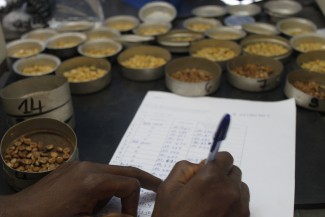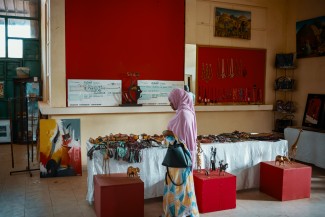Empowerment and markets are on this Ugandan woman’s agenda
How did you get started in the business of Ugandan crafts?
Back in 2008 after my university studies I went back home, and I would see these children playing on the side of the road and wonder why they weren’t in school and I started thinking how I could help change the mothers’ lives and help these children. Most of these women were making handicrafts for home consumption – because we eat from baskets. And since Tooro is a tourist area some women I would speak to had started making baskets and were selling along the roads.
Later on we started to develop ourselves and we started developing new products. Right now there are 700 women and some men also. Our core product is the baskets. What we have is a community-based organization. We are coming together as a community to develop ourselves around craft production.
Where do you sell your goods?
Tooro Gallery is in Fort Portal. Because of this work, I won an award from the Young Africa Leaders’ Initiative as a young African leader, and I developed a relationship with the American Embassy so I also sell there and meet buyers and take orders. Or when we come to events we market ourselves.
We’ve not gotten any funding at all, nothing. We wanted to move away from aid, you know the region was highly affected by war, and people were getting used to handouts. If you give us money, what next when it’s not there tomorrow? So let us buy materials, make a product and sell. Our profits have all been through selling our products.
And how is the income for the women you are partnered with?
I can say it is good money. We’ve seen some women who had thatched roof houses and went on to build houses with solid roofs. We have seen women now going to give birth at hospitals.
The women’s groups have accounts and we distribute to their accounts. We developed a passbook system to help us monitor how much is paid and how much is bought. For example, this group has 800 baskets and there are 100 members – everyone has numbers 1, 2 and so on and the passbook shows what you have produced and the other side shows how much you have been paid.
We didn’t want to come up with a project in the name of employing people and helping them benefit and yet they’re not being paid so we work to ensure that every last person who makes a basket is paid.
What materials are used in your products?
We use raffia from the central part of Uganda called Mpigi because it is good quality. We also work with an environmental officer who works with the local community nearby so as to manage and preserve the wetland where the raffia grows.
We also use natural dyes from plants. We are using for example red cabbage it gives you pink, or lemon or turmeric gives you yellow. There is a plant that gives us a variety of black depending on how you mix it, we get green, we get maroon, coffee brown.
And what about the designs?
We are trying to add a modern touch in an African way. We do have the neutrals, the earth colours and we also have the modern colours. So we go according to seasons and trends so we look around every January at what colours are going for the year.
Every buyer comes with their own preferences. Sometimes when we work with a buyer we ask them what is your inspiration and work accordingly, so I’ve learned to become a designer myself. I have to make sure I keep up-to-date, I go to Pinterest, I try to check other websites to see what is happening.
What do you hope for your business going forward?
We are looking at getting linked to markets and who can help us. Because our orders are not regular and if we go two months without production you wonder where another buyer is going to come from. So we need a more continuous process.
Finally, you are part of a new project with the Government and EIF that is working to support handicrafts and the tourism sector in Uganda. What’s going on there?
This tourism handicrafts project is really good because it is identifying Ugandan products, and handicrafts employs so many people, especially women in Uganda. As a person passionate about women’s empowerment and what we make here, I feel so bad when I see the products being made in other countries. Yet if we were empowered more, for example capacity building on quality and how to access raw materials, I know we’d be able to make our own higher quality products.
The handicrafts and creative industries have been left behind. Now that it is linked to tourism I think it will pick up. Once you have identified the items and the areas they are made, then I think momentum is going to be very easy.
-----
Mrs. Kalinzi’s community organization is part of a new initiative that supports the production of high quality, locally produced Uganda crafts and that is also working to ensure they are available to tourists. Read more about EIF’s new handicrafts and tourism partnership in Uganda here.
If you would like to reuse any material published here, please let us know by sending an email to EIF Communications: eifcommunications@wto.org.



